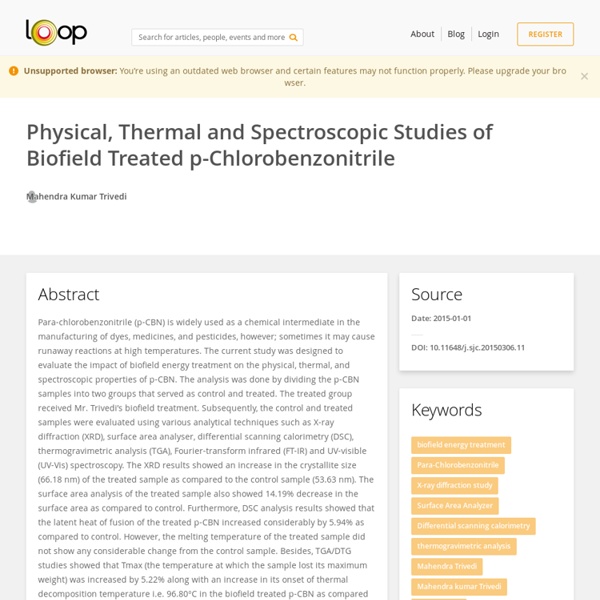



Biofield Energy Treatment on p-Chlorobenzonitrile Description Para-chlorobenzonitrile (p-CBN) is widely used as a chemical intermediate in the manufacturing of dyes, medicines, and pesticides, however; sometimes it may cause runaway reactions at high temperatures. The current study was designed to evaluate the impact of biofield energy treatment on the physical, thermal, and spectroscopic properties of p-CBN. The analysis was done by dividing the p-CBN samples into two groups that served as control and treated. The treated group received Mr. Citation Information Mahendra Kumar Trivedi, Alice Branton, Dahryn Trivedi, Gopal Nayak, Ragini Singh, Snehasis Jana.
Analytical Study of Para Chloro Benzonitrile Title: Physical, Thermal and Spectroscopic Studies of Biofield Treated p-Chlorobenzonitrile Publication: Science Journal of Chemistry Select license: Creative Commons Attributions-NonCommercial-ShareAlike 10.11648/j.sjc.20150306.11 Updated: November 21st, 2016 Abstract: Para-chlorobenzonitrile (p-CBN) is widely used as a chemical intermediate in the manufacturing of dyes, medicines, and pesticides, however; sometimes it may cause runaway reactions at high temperatures.
Physical, Thermal and Spectroscopic Studies of Biofield Treated p-Chlorobenzonitrile Para-chlorobenzonitrile (p-CBN) is widely used as a chemical intermediate in the manufacturing of dyes, medicines, and pesticides, however; sometimes it may cause runaway reactions at high temperatures. The current study was designed to evaluate the impact of biofield energy treatment on the physical, thermal, and spectroscopic properties of p-CBN. The analysis was done by dividing the p-CBN samples into two groups that served as control and treated. Science Journal of Chemistry | Biofield Treated p-Chlorobenzonitrile Physical, Thermal and Spectroscopic Studies of Biofield Treated p-Chlorobenzonitrile Science Journal of Chemistry Volume 3, Issue 6, December 2015, Pages: 84-90 Received: Sep. 19, 2015; Accepted: Sep. 30, 2015; Published: Oct. 16, 2015 DOI: 10.11648/j.sjc.20150306.11 Views 557 Downloads 25 Authors Mahendra Kumar Trivedi, Trivedi Global Inc., Henderson, USA Alice Branton, Trivedi Global Inc., Henderson, USA Dahryn Trivedi, Trivedi Global Inc., Henderson, USA Gopal Nayak, Trivedi Global Inc., Henderson, USA Ragini Singh, Trivedi Science Research Laboratory Pvt. Snehasis Jana, Trivedi Science Research Laboratory Pvt. Abstract Para-chlorobenzonitrile (p-CBN) is widely used as a chemical intermediate in the manufacturing of dyes, medicines, and pesticides, however; sometimes it may cause runaway reactions at high temperatures. Biofield Energy Treatment, Para-Chlorobenzonitrile, X-ray Diffraction Study, Surface Area Analyzer, Differential Scanning Calorimetry, Thermogravimetric Analysis
Mahendra Kumar Trivedi | Biography Mahendra Kumar Trivedi completed his Bachelor’s degree in Mechanical Engineering in 1985 and worked as an Engineer for 10 years. In 1995, Mr. Trivedi discovered that he has the unique ability to harness the energy from the universe and transmit it to anywhere on earth, infusing it into living organisms and nonliving materials to optimize their potential. Physical, Thermal and Spectral Properties of Biofield Treated 3-Nitroacetophenone Title: Physical, Thermal and Spectral Properties of Biofield Treated 3-Nitroacetophenone Publication: Science Journal of Analytical Chemistry Select license: Creative Commons Attributions-NonCommercial-ShareAlike 10.11648/j.sjac.20150306.11 Updated: November 21st, 2016 Abstract: 3-Nitroacetophenone (3-NAP) is an organic compound used as an intermediate for the synthesis of pharmaceutical agents.
Characteristic of Shigella sonnei after Biofield Treatment Abstract Shigella sonnei (S. sonnei) is a non-motile, rod shape, clinically significant, Gram-negative bacterium. It is commonly associated with dysentery (shigellosis). Recently, resistance to third and fourth generation cephalosporins and fluoroquinolones has been reported in S. sonnei. In the present study, we assessed the effect of biofield treatment on phenotyping and genotyping characteristic of S. sonnei (ATCC 9290). Tables at a glance Figures at a glance
Mahendra Trivedi on iScience About Mahendra Trivedi earned his 5-year Bachelor’s degree in Mechanical Engineering in 1985 and worked as an Engineer for 10 years. In 1995, Mr. Trivedi discovered that he had the unique ability to harness the energy from the universe and transmit it to anywhere on the globe, infusing it into living organisms and nonliving materials, thus optimizing their potential. Research Although Mr. He amassed a collection of over 4,000 scientific studies in many life sciences and material sciences, including: agriculture, livestock, biotechnology, microbiology, materials science, genetics, cancer and human health and has several dozens of publications in leading international peer-reviewed scientific journals, all in support to the dramatic results reported through human testimonials, thus excluding the possibility of the placebo effect. Mr. Mr. You can read more about Mr. 1). 2). 3). 4). 5). 6). 7). 8). 9).